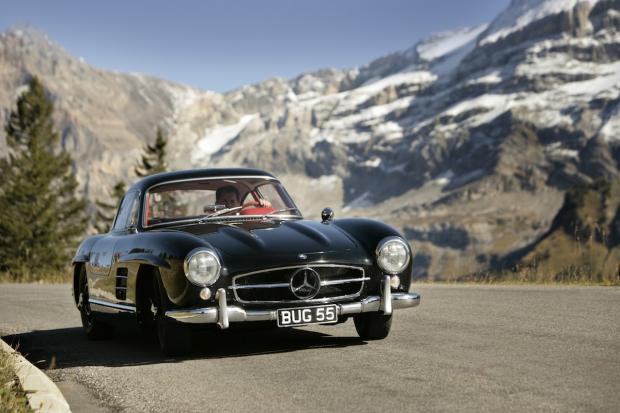The key is to drive smoothly and avoid any sudden weight transfer. Lift off sharply and it gets ugly as the rear wheels tuck under Triumph Herald-style before the back swings out. Thankfully the warning signs come early – any drama is immediately telegraphed to your lower back as the wheels skid and hop over the pavé. But respect its limitations with a slow entry, fast out approach to bends and the Gullwing is hugely rewarding to drive. Respectful of the car’s value and beauty, I’m not prepared to find its limits with a ravine on one side and rock faces on the other, but we make good time over the pass. Baker braces himself nervously most of the way, so our pace is pretty spirited. Going up is always more rewarding for me and, knowing the car’s braking limitations, I take it more cautiously going down.

We stop for a last coffee in the mountains and the Merc draws locals and tourists like no other car. Even vans and trucks stop just to admire it. Well wouldn’t you if you saw a black Gullwing parked en route to work? Unlike a modern supercar, there’s no stigma of ownership – people just want to study its beauty. Maybe a Miura rivals it for magnetic appeal but, as we prove over some of the greatest Alpine roads, the Gullwing’s allure is total. Little wonder they’re chasing ’50s Ferraris in value.
This summer I met a Bavarian enthusiast who has built a special ramp up into his living room. After a great drive in his Gullwing he motors up into the house, switches off, opens a good wine and settles down to admire it. It takes a special car to inspire such obsession.
Mercedes-Benz 300SL
Sold/number built 1954-’57/1400
Construction tubular steel spaceframe with steel body and aluminium skins
Engine front-mounted iron-block, alloy-head, chain-driven sohc 2996cc straight-six, with Bosch mechanical fuel injection
Max power 215bhp @ 5800rpm
Max torque 228lb ft @ 5000rpm
Transmission four-speed manual, driving rear wheels
Suspension: front double wishbones, coil springs and anti-roll bar rear swing axle, coil springs; telescopic dampers f/r
Steering recirculating ball
Brakes Alfin drums all round, with servo
Length 15ft (4572mm) Width 5ft 10 in (1791mm) Height 4ft 3 in (1302mm)
Wheelbase 7ft 10 in (2400mm)
Weight 3000lb (1361kg)
0-60mph 8.8 secs
Top speed 146mph Mpg 21
Price new £4393
Did you know?
1. The Gullwing’s drag coefficient was a high 0.425 even with a full undertray. With a 3.25:1 axle ratio, test engineer Arthur Mischke achieved a two-way maximum of 153.5mph on a closed autobahn in ’54, confirming it as the then fastest production car in the world. Several owners took their cars to the Bonneville Speed Trials including Albert Schmidt. After frustrations in 1955, he returned in ’56 and clocked a two-way average of 152mph. In 1959 he fitted a 6.7-litre Chrysler V8 but only managed a one-way run at 167mph.
2. D-B’s first injection was developed from aircraft designs before WW2 for the Type 80 LSR project. Weber carburetion was planned, and rival teams were set up, but by Christmas ’52 injection had won the day with 214bhp at 5960rpm. The beautifully made Bosch pump is essentially a mini six-cylinder engine driven off the crank by an exposed shaft.
3. During hot summer tests on the Grossglöckner, the fuel-injected car developed restarting problems, so an electric pump operated by a dash switch became standard. This flushed the injector plungers with cool fuel and swept out any vapour pockets. Once started the engine ran on just the mechanical pump but the electric unit was still advised for fast driving in hot weather.
4. The 300SL’s dry sump has a capacity of 10 litres and oil should to be changed every 1500 miles. Unused fuel from the early direct injection eventually mixes with the lubricant: a quick check is to smell for petrol on the dipstick.
5. The car made its New York debut with Dunlop Racing rubber, but for production Continental developed fast-road tyres. Tests were carried out on the autobahn in damp and dry weather with prototype tyres hand-cut by Rudy Uhlenhaut’s engineers to get the behaviour they wanted.
6. US East Coast Merc importer Max Hoffman was convinced there was a market for a civilised version of the 300SL racer. His guarantee to buy 500 meant the project got the green light.
7. The Gullwing door was changed three times before production. The first prototype had a handle with a hole for a finger grip; the second was a simple pushbutton. The final design used a flush handle that popped out by thumb pressure.
This article originally appeared in the February 2007 issue of Classic & Sports Car magazine, which retains the copyright to all words and images.
Mick Walsh
Mick Walsh is Classic & Sports Car’s International Editor










